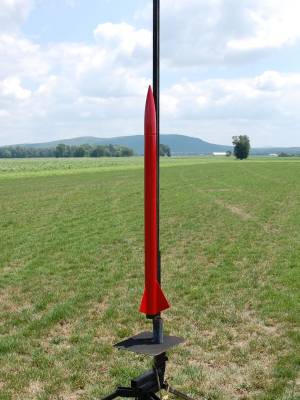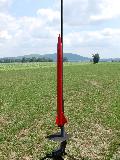| Manufacturer: | LOC/Precision  |
I chose the Nuke Pro Maxx because of it’s versatility. With it’s 38mm it allowed for flights from G’s to J’s. Shortly after I got the kit I decided if I wanted to fly anything larger than H power it might be best to modify it for dual deploy. Not having built a dual deploy rocket I had a little bit of a learning curve. It turned out that the mod was relatively easy. All I needed to purchase was a LOC 2.14” tube coupler stiffener and a pair of 2.14” bulkheads. These pieces would be used to convert the kit included coupler to an av-bay. The other items I needed to finish the mod was an altimeter and charge wells. I chose the PerfectFlight StratoLogger and charge wells from Blastcap Rocketry. To round out the build I went with a Classic Slimline 38mm motor retainer and a 5 grain CTI 38mm case.
As the build was in progress, it started to look like I might actually use the rocket for a level 2 attempt so I spent extra attention in building it strong and straight. The build was straight forward so no pictures were taken. In each of my builds I try to add a new skill or step that the previous rocket did not have. This time I added chopped carbon fiber to the epoxy used to glue the fins to the motor tube. This would create strong internal fillets in hopes of standing up to mach+ flights. I glued each fin on at a time carefully aligning them in a jig. Once they were all on I added fillets at the fin/body tube joint. This combined with the short span of the fins resulted in a very stiff aft end. After applying a couple coats of sanding sealer it was time for paint. I went with a simple all red scheme for simplicity.
It’s first flight was at the 2012 NERRF in Pine Island NY. After prepping the rocket for it’s first flight I loaded a CTI G60 Red and carried it out to the pad. After a short wait it was my turn. My rocket leaped off the pad with authority. It’s first flight was picture perfect. It went straight up with a perfect apogee separation and at the set 700’, the main popped out to gently set it down. I was surprised at the altitude it achieved on the small G, the altimeter beeped out 1722’.
Next it was time to go for the level 2 flight. After prepping the rocket again, I loaded a 5 grain CTI J335 Red. The size of this motor was a major jump up from the motors I have been flying. I knew this flight would be over a mile high so I installed a borrowed tracker and installed it on the apogee shock cord. As it turned out, this was the key to a successful flight. The rocket ripped off the pad and climbed straight up. At apogee, the tracking smoke was seen but nothing after that. After about a minute or so of staring at the sky, nobody was able to spot the rocket so it was time to pull out the tracker. The tracker picked up a faint signal that turned out to be transmitting from over two miles away. After the long hike, the rocket was recovered in perfect condition and the smile was still plastered on my face after the the long hike back to the pits. I knew the flight would be high and fast but I wasn’t prepared for the numbers the altimeter spit out. The Nuke reached an altitude of 7,736’ at just over a 1000 miles an hour. I had successfully completed my level 2 flight almost a mile and a half high and over mach 1.3! Not bad for a cardboard tube and a bit of plywood.
I want to thank LOC precision for making a wonderful and affordable kit that is capable of flying on a wide range of motors. A huge thanks goes out to Rick Comshaw for his advice, tracker and sharing the long walk to help retrieve my rocket.
Sponsored Ads
 |
 |













